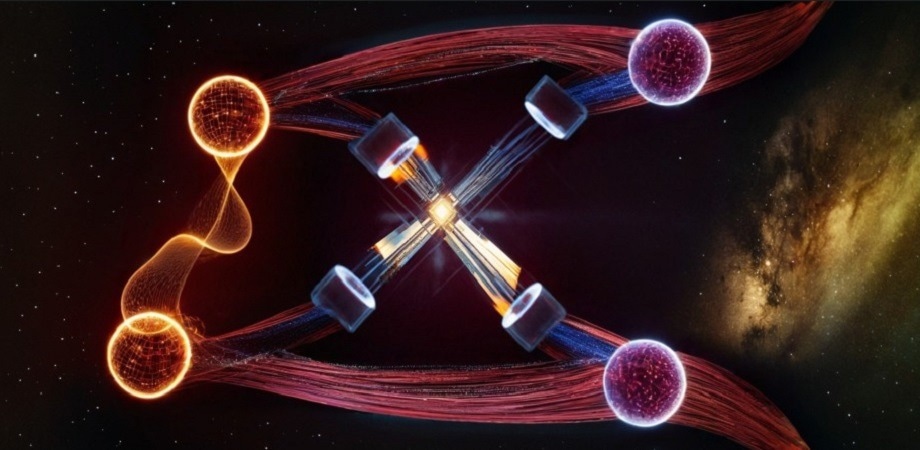Reviewed by Lexie CornerJun 6 2024
In a new study published in Advanced Photonics Nexus, an international team of researchers made significant strides in exploring the mysteries of quantum gravity. These findings shed new light on future research aimed at unifying quantum mechanics and general relativity.
 Artistic representation of the implemented photonic experiment in which entanglement between the polarizations of single photons is mediated by the independent degree of freedom of the photon path. Notably, mediated entanglement represents a core principle of future experiments using massive particles, aiming to probe the quantumness of gravity for the first time. Image Credit: Federico Alfano
Artistic representation of the implemented photonic experiment in which entanglement between the polarizations of single photons is mediated by the independent degree of freedom of the photon path. Notably, mediated entanglement represents a core principle of future experiments using massive particles, aiming to probe the quantumness of gravity for the first time. Image Credit: Federico Alfano
This study will help solve one of contemporary physics’ most fundamental enigmas: reconciling Einstein’s theory of gravity with principles of quantum mechanics.
For decades, scientists have been fascinated by the long-standing challenge of unifying these two pillars of physics. This has given rise to many theoretical frameworks, such as string theory and loop quantum gravity. However, without experimental evidence, these notions are theoretical.
How can the quantum nature of gravity be tested? Tangible methods to investigate the quantum behavior of the gravitational field have been developed in the last ten years (by Marletto and Vedral, and Bose et al.). These techniques were based on the idea of “gravity-mediated entanglement.”
The current study illustrates the concepts of gravity-mediated entanglement using light particles (i.e., photons). It utilizes state-of-the-art tools and techniques from quantum information theory and quantum optics.
The experiment uses photon interaction to simulate the influence of a gravitational field on quantum particles. Surprisingly, the photons' characteristics intertwine while never interacting, demonstrating nonlocality, a fundamental quantum phenomenon.
This entanglement mimics the expected behavior of gravity-induced entanglement and is mediated by another independent photonic feature, offering important new information on the quantum basis of gravity.
Most importantly, the study also tackles the difficulty of identifying the entanglement produced in these experiments. By addressing the limitations and noise sources inherent in such investigations, the researchers pave the way for clarifying concepts and tools for future studies targeted at directly witnessing gravity-mediated entanglement.
Gravity-mediated entanglement experiments can open a new chapter in the understanding of the fundamental properties of the universe.
The implications of this research are profound. It offers an experimental validation for the principles behind future quantum gravity experiments that will serve as litmus tests for competing theoretical frameworks.
Emanuele Polino, Study Author and Postdoctoral Scholar, Sapienza University
This remarkable finding represents a major step forward in understanding the secrets of quantum gravity, as physicists continue to push the frontiers of experimental and theoretical inquiry.
Journal Reference:
Polino, E., et al. (2024) Photonic implementation of quantum gravity simulator. Advanced Photonics Nexus. doi:10.1117/1.APN.3.3.036011